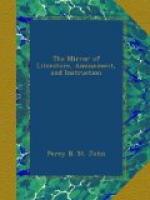Of the Royal Palace, suffice it to remark, in this place, that it is a large pile of building,—has been carried on with great rapidity of execution,—its whole exterior is stone, many parts of which are adorned with sculptured statues, basso-relievo, and other ornaments,—that a highly-decorated triumphal arch, composed of fine white, marble, is to be raised, at a short distance from the centre of the principal front—and that the interior is to be splendidly adorned with marble, scagliola, and other rich materials; whilst the galleries, armoury, chapel, state-rooms, &c. are to display the most gorgeous ornaments of the cabinet-maker, upholsterer, decorative painter, and other artisans.
The Park, in front of this palace, which had continued for nearly a century in one state of formal, tasteless insipidity, has been laid out as a large pleasure-garden, interspersed with lawn, clusters of shrubs and flowers, winding walks, varied surface, and a lake, whose margin is made to wind with every inequality of surface, spreading occasionally into a broad expanse, and then contracting to a narrow arm. In the midst of the larger spaces are islands, covered with aquatic trees and shrubs.
The Gardens, or Pleasure Grounds, belonging to the Palace, partake of the same character; but are adorned with shrubs, plants, and flowers of a more choice description. A large piece of water is likewise formed in the midst of these Gardens.
Belgrave Square, and Vicinity. Immediately to the west of the boundary-wall of the royal gardens is a tract of ground, which, in 1824, was open fields, intersected by mud-banks, and partly occupied by a few sheds, and inhabited by the lowest characters of society. In 1829, the same land, consisting of about 140 acres, is nearly covered with houses of the largest size, surrounding spacious squares, or skirting wide and handsome streets. Of all the extraordinary works carried into effect by London gentlemen and tradesmen, we may fairly adduce this as a pre-eminent example. In the space of about four years, the houses surrounding one large square, called Belgrave, have been erected, some of them finished and occupied, and several others, of nearly equal dimensions and value, completed.
The most prominent feature of this district is Belgrave Square, which includes within the front walls of the houses an area of about ten acres, the centre of which, enclosed by lofty and handsome railing, is laid out as a pleasure garden. The whole of the houses are large, lofty, and spacious, with stuccoed fronts, porches, balustraded balconies; and those in the centre of each side are decorated with columns, or three-quarter columns, vases on the parapet, &c.
Of Eaton Square, one portion only is built at present: as laid out, planted, and railed in, it is intended to occupy an area of about fourteen acres, and will be bounded by four rows of houses on the north side, and the like number on the south side, having the king’s private road extending east and west through the centre. It measures 600 yards long by 120 yards wide, between the houses. At the eastern extremity is a new church, built from the designs of Henry Hakewill, Esq.




